After a shower, I had a brief chat with a Dutch fellow we had seen in the pub the previous evening. He was working away at his laptop on one of the benches near the shower block; I presume he got better Wi-Fi reception there. He had tried to sail from Ijmuiden to the UK earlier in the year, but bad weather had forced him to delay the trip until next year. "Where do you head to when you cross the North Sea?" I enquired. "Lowestoft," he replied, "it is the shortest distance." This tallied with umpteen other Dutch sailors we had talked to in the past, they all head to Lowestoft. "But it is not a glamourous place," he added. I agreed it was a run-down town. He indicated he had work to do on his laptop, so I left him to It.
after toast plus Meryl's marmalade (I reckon she is a secret jam maker for Tiptree Jams near where she lives), we slipped our lines and weaved our way back into the Ijsselmeer. Our waypoint was the lock at Kornwerderzand on the eastern end of the Afsluitdijk. The region around the former Zuiderzee had been vulnerable to flooding. There were already plans to build a causeway in the 17th century. In 1916, a combination of a storm at sea and an enormous surge of water from the IJssel caused flooding in large parts of the area around the Zuiderzee. Dykes burst, people were killed and the damage was enormous. There had already been plans to tame the Zuiderzee for some time. Engineer Cornelis Lely was now asked to produce a plan for the construction of the Afsluitdijk. Work began in 1927 and the last section was completed in 1932. Kornwerderzand stood on a former artificial island which was created during the construction of the Afsluitdijk.
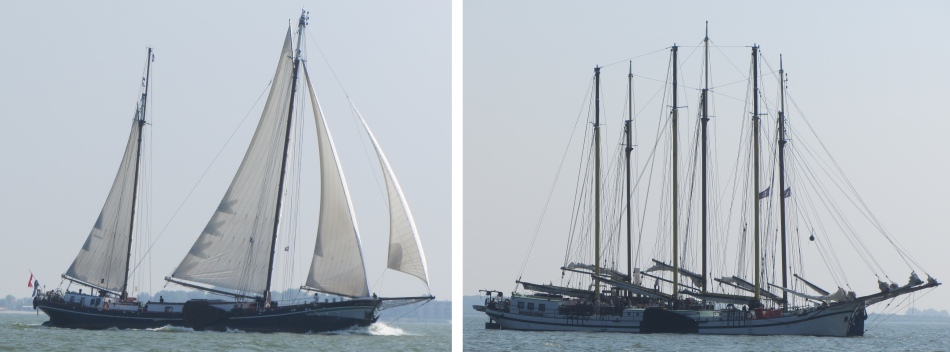 Tall Ships in the Ijsselmeer |
We arrived at the lock at the right time, and followed a line of yachts in. The yacht in front of us dithered about, with the crew dashing about to put fenders out. Rex went into mild irritation mode, and tried to pass the craft, but the craft accelerated each time to always ensure we were always behind. Rex was now fluently cursing in Dutch and Italian, the combined accent resembling a demented Dalek. We, however, effortlessly glided in and tied up.
The lockkeeper's buildings on either side of the lock were adorned with dozens of swallow nests. The small birds flew gracefully around the lock before returning to their homes.
Just as we were getting ready to leave the lock, two armed officials walked along the lock wall, and asked us if we could pull in on the right after the lock and bridge. We interpreted that as an order.
We crept out of the lock into a basin and shortly afterwards the bridge opened. The whole flotilla passed through. As expected the ditherers and boy racers moved into turbo charged mode and raced out into the Waddenzee.
Meanwhile we had to find somewhere to tie up for the officials to come on board. We spotted their patrol car already parked next to a small jetty, and they had started to walk down to it. There was no doubt where they wanted us to berth. The jetty was of metallic construction, brimming with lots of sharp, hard edges, all waiting to gouge holes in Duonita. We hurtled about raising our fenders to protect the boat. "Welcome," we said, "would you like to come on board? Perhaps some tea, coffee, whiskey or ...?" we asked.
They climbed aboard and kindly declined our hospitality (could be interpreted as bribes I suppose). They were not interested in our passports at all, that was a job for the immigration control. These lads were customs. I say lads, all these Dutch officials seem to be quite young. They were more interested in us having a valid boat entry document. There was now a new temporary import form that stated all the details about the boat: type, name, owner, when purchased, VAT status, call sign, MIS number etc. etc. This was all to do with traceability of the boat, the essence of the matter being if the boat were to be sold in Holland, they would need to know about it for tax purposes. We had never even heard of such a form. This did not deter the two officials, "We just happen to have one with us, and we can fill it in here," said the chap with an IPad taped to his hand.
The form was duly filled in, the men took photographs of it, and also of Rex's passport since he is the owner. Then the form was officially sealed and a photograph of that taken too. The stamp is valid for 18 months, after which the process needs to be repeated. A customs internal code number would need to be added to the form, and the fellow said he would email the code number to Rex within a day or two.
And that was it, and Rex had to hang on to the paper version of the form and add the code number when he was sent it. The two young guys were very pleasant and we exchanged a bit of banter. They covered a huge patch of Holland, and even big ships were in their remit. We joked with them about the "hostilities" often experienced in locks. They laughed and told us their stories too. Apparently some yachts have been known to totally screw up and end up spinning around in circles within the locks. We parted company with a shake of the hands, and them wishing us a safe trip and a good time.
Sadly this exercise had delayed us appreciably, and we had missed the aid of the tide in our onward journey up to Harlingen. Rex was quietly cursing in some foreign tongue I did not understand.
We passed through the Havenmond at Harlingen, motored up the Nieuwe Voorhaven past the ferry terminal, and gilled for a short while at the Tsjerk Hiddessluizen, one of the locks that connected the Friesland canals to the Waddenzee. The locks derived their name from Tjerk Hiddesz de Vries, an admiral who was killed in 1666 during a sea battle against England. Once negotiated, we passed through into the Van Harinxmakanaal. Then an abrupt right hand turn brought us into the Noordergracht and the HWSV marina: Harlinger Watersportvereniging (Harlinger Water Sports Association), active since 1932. We always stayed her when we were in Harlingen, it is quiet, cheap, and just a short walk into town. It hadn't changed at all over the Covid years, just a new database had been installed, so we had to reregister.
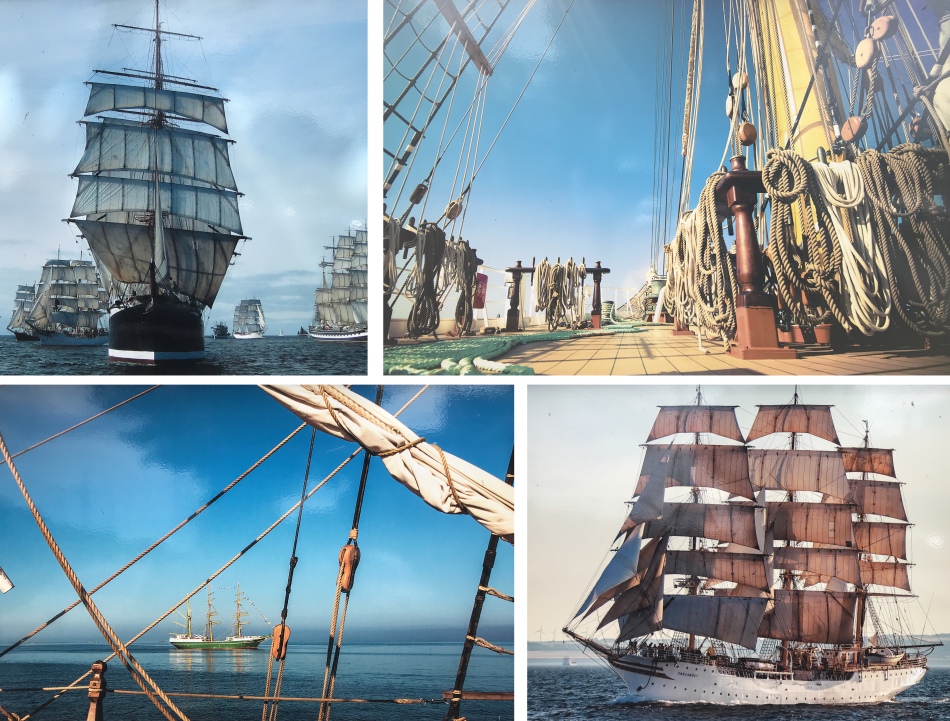 Tall Ships Posters in the Noorderhaven |
The international organiser of the Tall Ships Races is the UK-based charity Sail Training International (STI), the world's leading organiser of sailing races and events. The mission? To offer young people aged 15 to 25 the experience of a lifetime. Through sail training they introduce the young people to norms and values, they learn to develop team spirit, are given a physical challenge and they learn about themselves. STI is managed by its national members. In the Netherlands this is Sail Training Association Netherlands (STAN) in Oostvoorne.
In 1956, the first competition between twenty ships was organised by Bernard Morgan, a lawyer from London. The race went from Torquay, Devon to Lisbon. The public interest was so overwhelming that the organisers set up the Sail Training International association to also organise competitions in the following years.
In 2014, for the first time in the history of the Tall Ships Races, a Dutch harbour hosted the international sailing race. The large number of 337 trainees earned the Harlingen Sail Foundation an Award that year for the highest number of participating trainees ever. Four years later, Harlingen once again hosted the sailing race. The event attracted about 335,000 visitors that year.
Besides an impressive spectacle for the public, the Tall Ships Races is an event with a mission. Everything revolves around the personal development and education of young people by offering unique sail training, regardless of nationality, culture, religion, gender or social background. The historic port city of Harlingen is the perfect setting to welcome the mighty ships.
An impressive fleet, spectacular performances, impressive fireworks, the best weather, about 335,000 visitors and hundreds of trainees who have made the trip of a lifetime. The Tall Ships Races Harlingen 2018 was a four-day maritime celebration.
In the evening we made our way back into town, we had chance to reflect on the town's history. Harlingen is one of the original eleven cities of Friesland, connected by canals used in the long-distance ice skating event called "Elfstedentocht." You can visit these cities on skates if the ice is thick enough in the winter. The town was founded in 1243 near the site of the town of Grayn, which was engulfed by the sea in 1134. The harbour of Harlingen, which was formerly a considerable trading town, still exports Frisian products and imports coal, timber and other industrial raw materials. In the harbour area are shipyards, fish-processing plants, woodworking factories and works producing building materials. From the town, ferries cross to the islands of Vlieland and Terschelling, and the harbour is linked with Leeuwarden by the Van Harinxmakanaal.
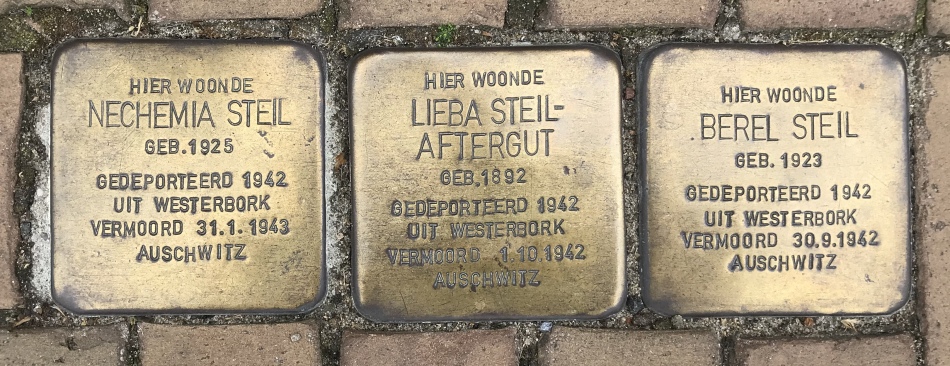 Plaques In the Pavement Recording Jews Who Had Lived in a Building Before Being Led Away by the Nazis |
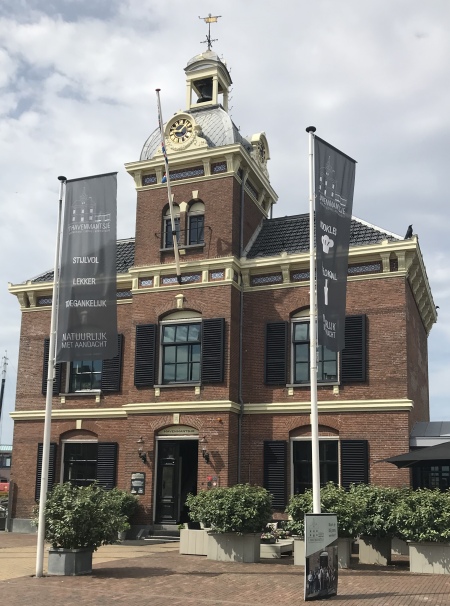 't Havenmantsje |
We plonked ourselves next to couple at the bar, passing greetings to them as we did so. They could tell from my ordering a couple of beers in Dutch that I wasn't Dutch, and the conversation started flowing from there.
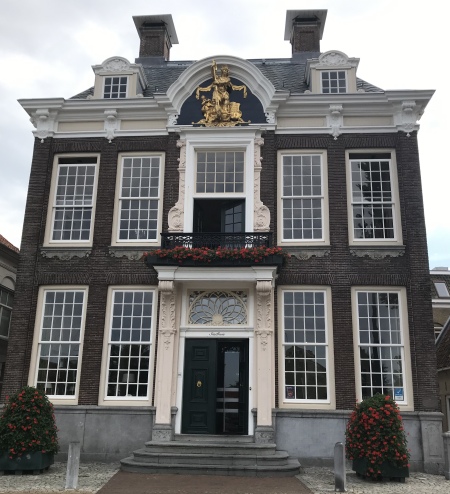 Stadhuis |
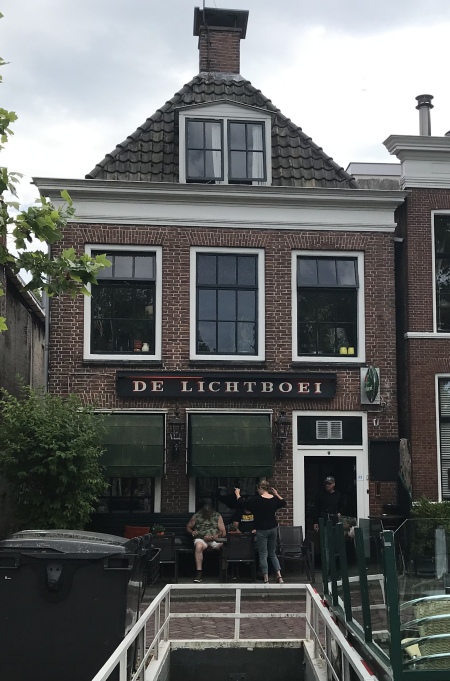 De Lichtboei |
Then we learned Jeerd was lucky to be alive. Earlier in the day he'd had a very narrow escape. Their boat, which was moored in the Noorderhaven, had a petrol engine, a rare engine for boats. The problem with petrol engines on boats is petrol fumes can accumulate in confined spaces. It only takes a small spark, then BANG! Despite having a blower on board to disperse any fumes, his boat had exploded, totally destroying a steel shutter. Jeerd had been on board at the time. Now he had no eye brows or hair on his legs, and his arm was bandaged where he was burned. His injuries didn't perturb him, the shock had affected him more, but most of all his pride had been hurt. His boat was still sailable, but he was now determined to replace the engine with a diesel equivalent.
Jeerd was drinking a Belgian beer plus a Kornwijn chaser (a drink matured in the barrel for ten years), and Monique drank Portwijn. He insisted we try the Kornwijn - a terrible mistake!
Our table was ready, as was theirs, so we parted company, and Rex and I enjoyed a superb meal. The food at this restaurant is special. Fully replete, we went downstairs to pay, and the couple asked us to join them at their table. More drinks followed.
We learned that Jeerd now worked as a process engineer. Monique worked in a pathology lab. He was critical of how the health service had deteriorated in Holland over recent years; the emphasis now being getting people out of hospital as quickly as possible. He was definitely not a fan of the Germans. Rex tried to discuss football with Jeerd since he supported one of the Dutch teams, but with no success. He was equally disappointed when he tried to discuss books too.
After far too any drinks, we all tottered out of the restaurant, the last customers to leave. It was pouring with rain. We escorted them to their boat in the Noorderhaven, bade them farewell, and we somehow found our way back to Duonita where we slipped into oblivion.
